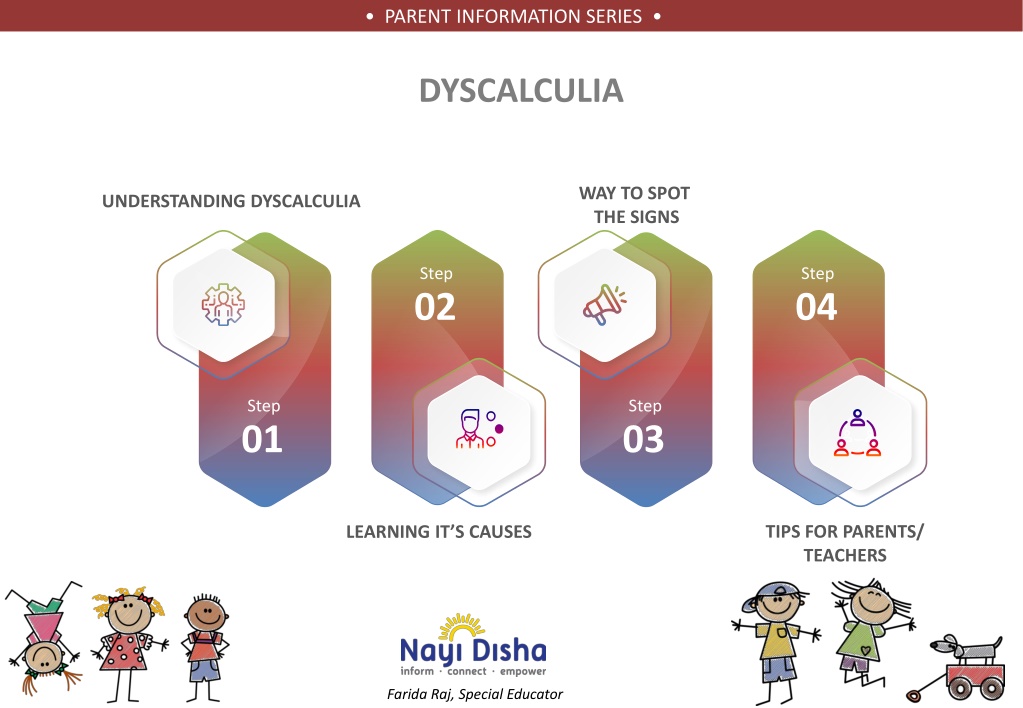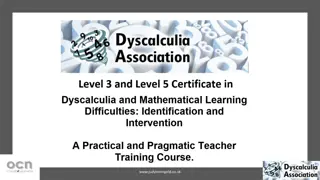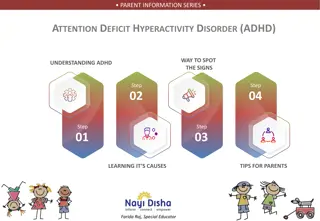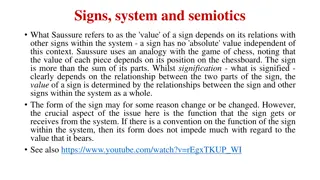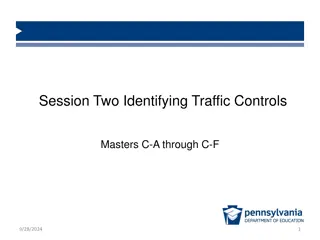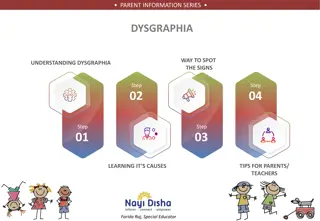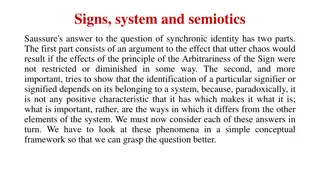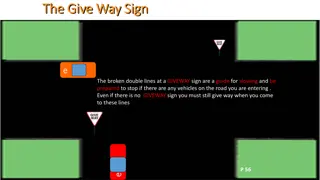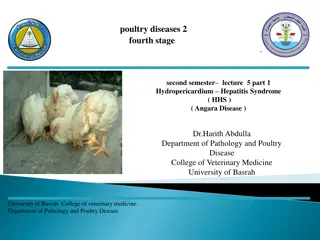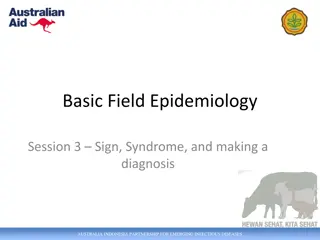Understanding Dyscalculia: Signs, Causes, and Tips for Parents
Dyscalculia is a mathematical disability affecting a child's ability to solve arithmetic problems and grasp math concepts. Identifying signs like difficulty in problem-solving, uneven performance, and memory issues is crucial. Neurological factors, school attendance interruptions, visual functioning disorders, distractibility, reading difficulties, and perception disorders can contribute to dyscalculia. Special educators like Farida Raj stress the importance of supporting children with dyscalculia in everyday math skills.
Download Presentation

Please find below an Image/Link to download the presentation.
The content on the website is provided AS IS for your information and personal use only. It may not be sold, licensed, or shared on other websites without obtaining consent from the author. Download presentation by click this link. If you encounter any issues during the download, it is possible that the publisher has removed the file from their server.
E N D
Presentation Transcript
PARENT INFORMATION SERIES DYSCALCULIA WAY TO SPOT THE SIGNS UNDERSTANDING DYSCALCULIA Step Step 02 04 Step Step 01 03 TIPS FOR PARENTS/ TEACHERS LEARNING IT S CAUSES Farida Raj, Special Educator
UNDERSTANDING DYSCALCULIA LEARNING ITS CAUSES WAY TO SPOT THE SIGNS TIPS FOR PARENTS UNDERSTANDING DYSCALCULIA Dyscalculia is a mathematical disability in which a learner finds it difficult to solve arithmetic problems and have trouble grasping other math concepts. Most school-going children have trouble with learning mathematics, but those with a learning disability experience significant difficulty with the subject. Some are easily distracted while others find fact memorization particularly difficult. Children with Dyscalculia may exhibit Difficulty in problem solving Mathematical skill gaps Uneven performance Difficulty in remembering words or their meaning Farida Raj, Special Educator
UNDERSTANDING DYSCALCULIA LEARNING ITS CAUSES WAY TO SPOT THE SIGNS TIPS FOR PARENTS UNDERSTANDING DYSCALCULIA Mathematical skills are required for everyday life. Handling money Telling time Measurement taking are all part of everyday life. It is important that children with Dyscalculia are helped in overcoming these difficulties. Farida Raj, Special Educator
UNDERSTANDING DYSCALCULIA LEARNING ITS CAUSES WAY TO SPOT THE SIGNS TIPS FOR PARENTS LEARNING ITS CAUSES NEUROLOGICAL FACTORS : Lesions in the brain, particularly in the right hemisphere, affect spatial perception and visual-spatial memory which in turn impairs calculation skills. INTERRUPTION IN SCHOOL ATTENDANCE : Competency in mathematics depends on understanding of sequential steps and mastering each step in succession. Frequent absence from school will result in missing out on critical stages of learning and, as a consequence, the child will not be able to keep up with his peers. VISUAL FUNCTIONING DISORDER : Occurrence of frequent refractive errors, squint, defective visual scanning of a set of numbers and disoriented eye movements could affect simple calculating functions. Farida Raj, Special Educator
UNDERSTANDING DYSCALCULIA LEARNING ITS CAUSES WAY TO SPOT THE SIGNS TIPS FOR PARENTS LEARNING ITS CAUSES DISTRACTIBILITY: Problems with math can also be due to the child s inability to keep his/her mind persistently on the task on hand. Such a child is stimulus bound where he/she is unable to ignore various stimuli that they receive. DIFFICULTY IN READING FLUENTLY : A child who has significant difficulty with reading does not understand what he reads, asks questions about meaning of words, and does not remember what he reads will be poor in math. One must also bear in mind that the child may read adequately but has trouble with technical and sub-technical vocabulary used in solving math problems. DISORDER OF PERCEPTION : Visual perception is required in nearly everything we do. Good visual perception helps a child read, write, spell and do math. Disorders in perception lead to trouble in recognizing shapes, in matching and discriminating forms, copying and constructing shapes. Farida Raj, Special Educator
UNDERSTANDING DYSCALCULIA LEARNING ITS CAUSES WAY TO SPOT THE SIGNS TIPS FOR PARENTS WAYS TO SPOT SIGNS Signs of problems in mathematics DIFFICULTY : In pointing to small/ big, more /less, tall/short when asked. To demonstrate that adding more objects results in increase in quantity, taking away results in decreasing. To show that parts put together make a whole. In arranging/grouping objects by size/shape/color. In relating the number of objects to its symbol, written or verbal. In pointing to the numeral when named. In naming numerals. Reversal of numbers (e.g. 45 for 54, 503 for 305) In copying numbers Inability to apply computational skill to everyday activity In understanding concepts of units/ tens/ hundreds in numbers. In making mathematical judgment and reasoning. Farida Raj, Special Educator
UNDERSTANDING DYSCALCULIA LEARNING ITS CAUSES WAY TO SPOT THE SIGNS TIPS FOR PARENTS TIPS FOR PARENTS Teach the child to understand symbols such as +, -,x, /, = etc. abbreviations and numerical. Make the child proficient with technical vocabulary (numerator, quotient) & common words with special meaning (product, dividend, power). Encourage the child to read the problems twice. First silently and then aloud. Ask the child to verbalize the problem. Self-verbalization of the problem helps in determining its nature and what process should be used to solve it. Help them decipher pictures, diagrams and convert graphic information into mathematical statements. You can also enhance the learning process of the child by verbalizing while doing mathematical problems. Farida Raj, Special Educator
UNDERSTANDING DYSCALCULIA LEARNING ITS CAUSES WAY TO SPOT THE SIGNS TIPS FOR PARENTS TIPS FOR PARENTS Present the problem orally or pair the child with a peer who can easily read the material. Build a background of concrete experience for each problem. Give practice in similar problems to work out. Rehearsal and practice involve structured practice of specific behaviors. The goal of this approach is to enhance skill acquisition and maintenance after the child has learned the basic skill. Teach visualization. It encourages the child to try and see the problem in his mind s eye. It is important mathematical skill and it fosters understanding, organization and imagination. Farida Raj, Special Educator
UNDERSTANDING DYSCALCULIA LEARNING ITS CAUSES WAY TO SPOT THE SIGNS TIPS FOR PARENTS TIPS FOR PARENTS Help children understand better by giving vocabulary for different words that mean the same, as shown to the right. Farida Raj, Special Educator
This content has been developed in collaboration with Remedial & Special Educator Ms.Farida Raj. It has been adapted from her book ''Breaking Through" - A Hand Book for Teachers and Parents of Children with Learning Difficulties & reproduced here with consent NAYI DISHA RESOURCE CENTRE Join Us on Facebook Nayi Disha Resource Centre is an online information resource platform that supports families of persons with, Specific Learning Disabilities, Intellectual & Developmental Disabilities. Join Us on Twitter Join Us on Linkedin Visit us at WWW.NAYI-DISHA.ORG
